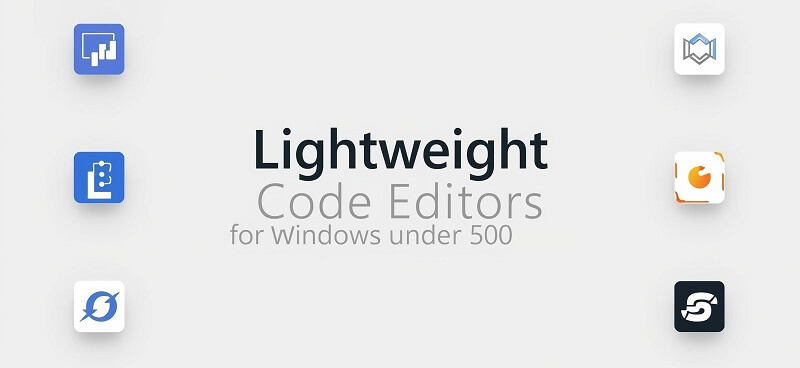In today’s fast -book world of software coding, equipment working with you can differentiate your productivity. Developers often rely on a feature-packed integrated growth environment (IDE), but these systems can be hungry. For coders who value quickness, simplicity and efficiency, light code editors are ideal solutions.
If you are on a Windows platform, you would have seen editors taking gigabytes of space and bogging down performance. This is where lightweight code editors under 500 MB stand out. They are fast, efficient, and reliable — much like free SEO tools for indie developers, which help optimize visibility and performance without consuming heavy system resources.
This article explores the best lightweight code editors for Windows under 500 MB in 2025, highlighting their features, benefits, and why they are great for developers who want speed without compromise.
Why choose light code editors?
Before diving in the list, it is important to understand why developers select light editors on large IDs.
1. Speed and Performance
Big IDEs such as Visual Studio or IntelliJ IDEA are feature-rich but heavy on resources. Small editors boot up quickly and let programmers get on with the coding instead of waiting for the software to boot.
2. Reduced Storage Needs
Editors below 500 MB consume less storage space, which is particularly beneficial if you are developing on a laptop or have a small number of SSDs with limited capacity.
3. Simplicity
Lightweight editors offer only what you require. They stay free from clutter and distractions so you can concentrate.
4. Portability
Smaller editors can conveniently be made portable apps, which is to say you can directly execute them from a USB drive without installing.
5. Customization
Although lightweight, most editors have the facility for plugins or extensions so you can include additional functionality without cluttering the system.
Best Lightweight Code Editors for Windows Under 500 MB
Here’s the list of best editors you can download and install on your Windows computer without having to worry about storage or performance problems.
1. Visual Studio Code (vs Code)
Size: About 300-400 MB on installation.
Visual Studio Code, or VS code as usually referred to, is one of the best code editors in the world. Despite having so much convenience, it still does not cross 500 MB, making it a powerful yet a mild editor.
key features:
- Syntax highlighting for several hundred languages.
- Integrated terminal.
- Debugging support.
- The built -in guit integration.
- The huge market of extension.
Why it is great: vs. code finds the correct balance of performance and capacity. You can start small and grow with your projects.
Best for: Web developers, python developers, and whoever wants a multi -purpose editor.
2. Sublime Text
Size: ~80 MB.
Sublime Text is very fast and responsive. It takes only seconds to load, even for big projects. Its clean interface today allows it to be one of the world’s top light editors.
major features:
- Lightning speed startup.
- “Goto Kuch” with fast navigation.
- Many cursors to edit.
- Extensive plugin ecosystem.
- Distraction-unfastened writing mode.
Why it is so tremendous: The chic textual content is small in size, but fantastically powerful. It is one of the quickest editors on the Windows platform.
Best for: Developers who prefer pace and simplicity of use above the whole thing.
3. Notepad++
Size: ~10 MB.
Notepad ++ is the lightest editor in this list. It is widely popular among Windows users over the years, due to its minuscule size and stable performance.
key features:
- Syntax highlighting in 70+ languages.
- Extremely small file size.
- Tabled Editing of many files.
- Support for plugins to customize.
- Open-source and free.
Why it is great: there is no competition when talking about size and lightness. Under 10 MB in size, it will not reduce almost any machine.
Best for: Early, Hobbies and Developers that only require a simple, light editor.
4. Atom
Size: ~200 MB.
Atom is another light but new-school editor created by Github. While the progress has slowed down in recent years, it still enjoys a lot of popularity as it is open-source and can be adapted.
key features:
- Cross-platform compatibility.
- Integrated Package Manager.
- Taletype functionality for real -time cooperation.
- File system browser.
- Github integration.
Why it is great: Atom is ideal for developers who give importance to flexibility. This can be as basic or sophisticated as you include, based on you.
Best for: Developers who enjoy an open-source editor with community-active features.
5. Brackets
Size: ~75 MB.
Brackets is a light editor geared towards web development. Created by Adobe, it has features best for HTML, CSS, and JavaScript.
key features:
- Live preview in browser.
- Inline editing of CSS and JavaScript.
- Preprocessor Support (Crown, Case).
- Open-source and community-supported.
Why it is great: brackets are small but skilled. It is an ideal choice for front-end developers, which require a free, lighting equipment with live preview.
Best for: Web designer and front-end developers.
6. Geany
Size: ~20 MB.
Geany is a very light and quick editor that comes close to being a small IDE. It is open-source and supports many programming languages.
Major features:
- Syntax highlighting for over dozens of languages.
- Auto-completion.
- Compile and execute code in place.
- Plugin support.
Why It’s Great: Geany offers IDE-like features without the big footprint. Developers who wish for simplicity with a hint of power will love it.
Best For: Developers who need a light alternative to usual IDEs.
7. Bluefish
Size: ~50 MB.
Bluefish is yet another light editor with focus on web development. It is famous for getting quick, even when working on huge projects with thousands of lines of code.
Key Features:
- Multi-document interface.
- Syntax highlighting.
- Search and replace in multiple files.
- Lightweight design.
Why It’s Great: Bluefish is light in weight but powerful enough to take on big coding projects with ease.
Best For: Developers who work on large websites or applications with numerous files.
8. CodeLite
Size: ~ 150 MB.
Codelite is a light, open-source idea that serves as a strong code editor for various languages such as C, C ++, PHP and JavaScript.
key features:
- Dibgon is available.
- Cross-platform compatible.
- Project Management Utilities.
- GIT support.
Why it is great: Codelite is like a mini IDE, but remains below 500 MB. It is excellent for freelancers who require more features without losing speed.
Best for: C/C ++ Programmer who requires a lean editor with debug support.
9. Kate
Size: ~60 MB.
Kate (KDE Advanced Text Editor) is a high -power editor that has originated in Linux, but is now available on Windows. It is on the side of the programmer, which requires performance as well as multi-document editing.
key features:
- Support for split-view editing.
- Syntax highlighting of 300+ languages.
- Built-in terminal.
- Plugin functionality.
Why It’s Great: Kate is very efficient and versatile, offering advanced functionality without being heavy.
Best For: Multiple-file developers.
10. Vim for Windows)
Size: ~8 MB.
Vim is a legendary editor for power users. It is highly lightweight, but has a higher learning curve. For the Windows crowd, gVim is an available graphical interface.
Key Features:
- Very lightweight.
- Keyboard-oriented editing.
- Highly customizable.
- Gigantic community support.
Why It’s Great: After you learn Vim, it can significantly improve the speed of your coding process.
Best For: Advanced developers who appreciate speed and efficiency.
Key Advantages of Lightweight Code Editors
Quicker Startup and Performance
Lightweight editors store time due to the fact they start up speedy and operate easily.
Improved Battery Life for Laptops
They consume less device assets, imparting longer battery existence during extended coding sessions.
Free-of-Charge Options
Most lightweight editors are either free or open-source, and therefore best suited for students and freelancers.
Streamlined Features
They offer you with handiest what you require—syntax highlighting, document navigation, and plugins—with none extras.
Flexibility
From amateur to expert users, most of these editors may be tailored to match diverse workflows.
Choosing the Right Lightweight Editor
In choosing an editor, take note of:
- Programming Languages: All editors do not equally support all languages.
- Extensions/Plugins: Do you require Git support, debugging, or frameworks?
- User Interface: Simple or featureful?
- Learning Curve: Simple setup (Notepad++) or deep control (Vim)?
- Community Support: Popular editors such as VS Code and Sublime have more substantial communities.
The Future of Lightweight Editors
2025 and beyond, light code editors will remain strong. As the need for speed and mobility increases, developers will move towards editors who balance simplicity with advanced features. Code complexes run by AI and Cloud Integration will also become ideal in light applications.
Final Verdict: Code Editors for Windows Under 500 MB
The best lighter code editors for windows under 500 MB prove that size does not always mean strength. Tools such as vs. code and sublime lessons provide modern features, while editors such as Nonepad ++ and Vim provide minimalism in their best form.
Whether you are an early or an experienced programmer, a lighter editor matches your style. They save space, run fast, and make coding more enjoyable – all without more than 500 MB.
If you are looking for speed, simplicity and stability, selecting a light-weight editor is one of the most intelligent decisions that you can make as a developer in 2025.









